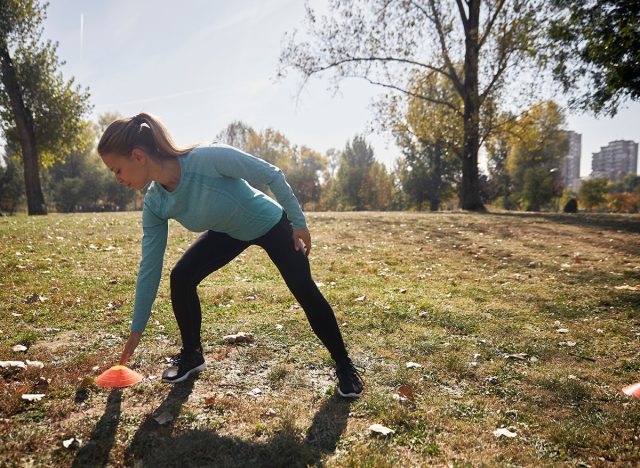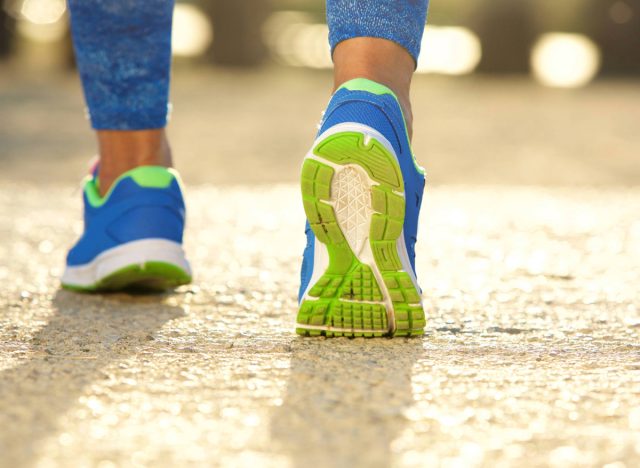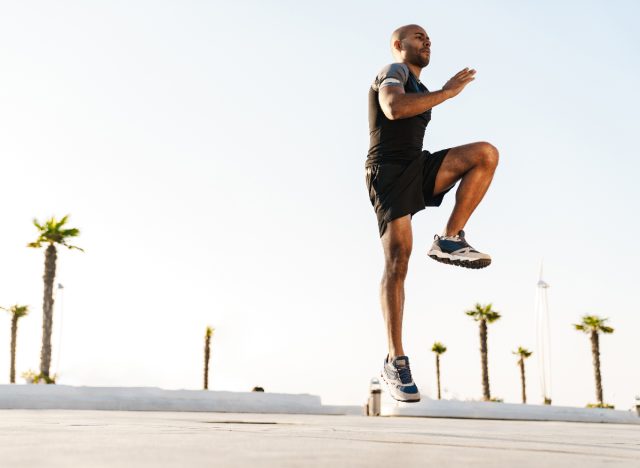5-Step Agility Circuit That Reveals If You’re Really Fit After 50
You may work out regularly, but are you really fit? If you’re 50 or over, we’re here with a fitness expert’s five-step agility circuit that will answer that question for you.
According to Aaron Loynes, PT, MPT, CSCS, clinical director at FYZICAL Therapy & Balance Centers of Novi, agility combines strength, speed, coordination, stability, and reaction, blending all key markers of fitness pertaining to athleticism. Agility is something many athletes focus on, but it’s also necessary in daily life, as it helps keep you functioning properly on your feet and prevents falls.
“For people over 50, all of these components are important for maintaining an active lifestyle and as we move on into the 60s maintaining agility will lead to less chances of falls and fall related injuries,” Aaron explains.
To make true progress, Aaron recommends performing the below circuit two to three times a week, depending on how your fitness levels rate.
“For testing purposes, I recommend getting ‘baseline’ measurements on the first session and re-assessing every four weeks,” he says. “Testing more frequently may not be beneficial as it takes time to adapt and progress. Each component below mentions a marker that can be measured, you would be looking to see faster times or more repetitions based on the initial measurements.”
Now, let’s explore Aaron’s five-step agility circuit you can do to stay fit at 50 and beyond.
The 5-Step Agility Circuit Reveals Your Fitness
All you need to get started is a stopwatch, supportive workout shoes, a set of small cones or similar markers, and some chalk or painter’s tape.
Aaron recommends doing a light 5 to 10-minute warm-up before your agility workout, such as a brisk walk, light treadmill jog, or ride on an exercise bike. This will prime your muscles.
Once done, you can begin the below circuit.
“These exercises can be performed consecutively as a circuit to get the heart rate up and burn some calories and also to increase endurance,” Aaron explains. “As you get more comfortable with the exercises you can perform more rounds of the circuit to continue to increase the level of challenge.”
Agility Drill: Shuttle Run

“This works on your ability to quickly start moving, quickly stop, and quickly change directions,” Aaron says.
- Line up 5 cones, spacing them 5 to 10 feet apart.
- Begin at the first cone.
- Run to cone #2, then quickly switch directions, returning to the first cone.
- Quickly run to the third cone.
- Return to the first cone.
- Continue the process until you run to each cone.
- Time how long it takes you to complete the drill.
- To make things more challenging, move the cones further apart, incorporate additional cones, or perform the pattern more than once in a row before breaking to rest.
Agility Drill: Carioca Side Shuffle

“For this exercise, you will go as quickly as possible to the right from the first cone. When you reach the second cone, you will quickly change directions and head back to the start,” Aaron explains. “This trains coordination, proprioception (knowing where you are in space), and quick direction changes.”
- Line up 2 cones 10 to 20 feet apart.
- The carioca, or grapevine, is a sideways shuffle movement, crossing your feet over each other.
- Start moving the right, crossing your left foot over your right foot.
- Next, use your right foot to step to the right.
- Bring your left foot behind your right foot.
- The right foot side steps.
- Time how long it takes you to complete one lap.
- Progress by increasing the distance between each cone.
Agility Drill: Forward/Backward Shuffle

“This challenges your balance and proprioception more because you are not able to rely on your vision for as much while moving backward,” Aaron says.
- Your cones will be set the same as they were in the carioca side shuffle.
- Start at the first cone.
- Run to the next cone.
- Run backward to the starting cone.
- Time how long it takes you to finish one lap.
- To progress, complete multiple reps, increase the distance, or bump up your speed.
Agility Drill: Quick Feet

“This improves foot speed and coordination,” Aaron tells us.
- Place 2 cones 10 feet apart.
- Begin at the first cone.
- Quickly alternate tapping your feet on the floor while moving forward to cone #2.
- Maintain short, light steps. Aaron compares it to running on “hot lava” on your toes.
- When you reach the second cone, turn around.
- Time how long it takes you to get from one cone to the other.
- To progress, move the cones further apart or turn around and do a loop back to the starting cone.
Agility Drill: Line Hops

“Hopping adds in explosive power, coordination, and improved foot speed,” Aaron explains.
- Use some chalk or tape to draw a line on the pavement.
- Set your timer for 15 to 30 seconds.
- Hop forward over the line you drew.
- Quickly hop backward.
- Repeat the drill until the timer stops.
- Track how many times you’re able to cross the line before the timer sounds.
- To progress, add more time or draw a plus sign on the pavement and incorporate hops in various directions.
